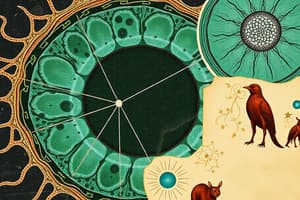Podcast
Questions and Answers
Which characteristic is NOT associated with phylum Anellida?
Which characteristic is NOT associated with phylum Anellida?
- True body cavity or coelom
- Metamerically segmented bodies
- Possess soft unsegmented bodies (correct)
- Complete alimentary canal
All members of phylum Mollusca have a calcareous shell.
All members of phylum Mollusca have a calcareous shell.
False (B)
Name one common member of phylum Arthropoda.
Name one common member of phylum Arthropoda.
Lobster, grasshopper, spider, or centipede
The body structure of Anellida is characterized by __________ segments.
The body structure of Anellida is characterized by __________ segments.
Match the following phyla with their characteristics:
Match the following phyla with their characteristics:
Which of the following characteristics is true for dicotyledonous plants?
Which of the following characteristics is true for dicotyledonous plants?
Angiosperms undergo secondary growth/thickening.
Angiosperms undergo secondary growth/thickening.
Name one common example of a monocotyledonous plant.
Name one common example of a monocotyledonous plant.
Dicotyledonous plants have a ______ root system.
Dicotyledonous plants have a ______ root system.
Match the following features with their respective plant classes:
Match the following features with their respective plant classes:
Which of the following structures is unique to plant cells?
Which of the following structures is unique to plant cells?
Animal cells have a rigid cell wall.
Animal cells have a rigid cell wall.
What is the basic unit of structure and function in living organisms?
What is the basic unit of structure and function in living organisms?
Plant cells typically have a ______ that provides structure and support.
Plant cells typically have a ______ that provides structure and support.
Match the cell structure with its corresponding function:
Match the cell structure with its corresponding function:
Which of the following best describes the cytoplasm of animal cells compared to plant cells?
Which of the following best describes the cytoplasm of animal cells compared to plant cells?
Both plant and animal cells have a large central vacuole.
Both plant and animal cells have a large central vacuole.
Name one type of tissue found in humans.
Name one type of tissue found in humans.
What plays a significant role in the specificity of enzymes?
What plays a significant role in the specificity of enzymes?
Enzymes can be denatured if exposed to high temperatures.
Enzymes can be denatured if exposed to high temperatures.
What is the term used to describe the shape of the enzyme’s active site that allows it to bind to its specific substrate?
What is the term used to describe the shape of the enzyme’s active site that allows it to bind to its specific substrate?
Enzymes are needed in __________ quantities to catalyze reactions.
Enzymes are needed in __________ quantities to catalyze reactions.
Match the following characteristics of enzymes with their descriptions:
Match the following characteristics of enzymes with their descriptions:
What is the optimum temperature for an enzyme?
What is the optimum temperature for an enzyme?
Coenzymes enhance the action of enzymes.
Coenzymes enhance the action of enzymes.
What happens to the enzyme-substrate complex after the reaction takes place?
What happens to the enzyme-substrate complex after the reaction takes place?
What is the correct order of levels of organization in biological systems?
What is the correct order of levels of organization in biological systems?
An organism can be formed by only one cell.
An organism can be formed by only one cell.
Name the organ system responsible for transportation of oxygen in the human body.
Name the organ system responsible for transportation of oxygen in the human body.
Cells that transport water through plants are called ______.
Cells that transport water through plants are called ______.
Match the specialized cells with their functions:
Match the specialized cells with their functions:
Which of the following is NOT one of the 11 organ systems in the human body?
Which of the following is NOT one of the 11 organ systems in the human body?
Bone cells are part of the nervous system.
Bone cells are part of the nervous system.
What unit is commonly used to measure organelles within cells?
What unit is commonly used to measure organelles within cells?
Flashcards are hidden until you start studying
Study Notes
Class Angiospermae (Characteristics)
- Most complex group of green plants, characterized by advanced structures.
- Vascular plants that produce complete, well-developed flowers.
- Seeds are enclosed within fruits, providing protection and aiding in dispersal.
- Specialized reproductive mechanisms including pollination and fertilization.
- Divided into two subclasses: Monocotyledonaceae (monocots) and Dicotyledonaceae (dicots).
Sub-Class Monocotyledonaceae (Characteristics)
- Seeds contain only one cotyledon.
- Leaves feature parallel venation, aiding in efficient water transport.
- Lack secondary growth, resulting in non-woody structures.
- Fibrous root systems provide stability and nutrient absorption.
- Floral parts are typically in groups of three or multiples thereof.
- Vascular bundles are scattered within the stem structure.
- Common examples include cereals, oil palm, and grasses.
Sub-Class Dicotyledonaceae (Characteristics)
- Seeds have two cotyledons, providing dual nutrient sources during germination.
- Leaves exhibit reticulate (net-like) venation patterns.
- Undergo secondary growth/thickening, resulting in woody structures.
- Possess a tap root system for deep soil penetration and support.
- Floral parts occur in groups of four or five.
- Vascular bundles arranged in a ring form within the stem.
- Common examples include mangoes, oranges, cowpeas, and balsam plants.
Phylum Annelida (Characteristics)
- Metamerically segmented worms featuring distinct internal and external segments.
- Characterized by long, cylindrical bodies.
- Possesses a true body cavity known as a coelom.
- Habitat includes both aquatic and terrestrial environments.
- Complete alimentary canal with two openings for food processing.
- Exhibits sexual reproduction and hermaphroditic traits in some species.
- Comprised of three distinct tissue layers (triploblastic).
- Common members include earthworms, leeches, and tubeworms.
Phylum Mollusca (Characteristics)
- Soft-bodied invertebrates that lack segmentation.
- Possess tentacles on their heads for sensory functions.
- Feature a muscular foot adapted for crawling or burrowing.
- Bodies are covered by a soft tissue called mantle.
- Some species have a calcareous shell for protection.
- Include both aquatic and terrestrial species.
- Sensitivity is enhanced through eyes and tentacles.
- Common members include mussels, snails, octopus, oysters, and slugs.
Phylum Arthropoda (Characteristics)
- Largest phylum within the kingdom Animalia; characterized by jointed limbs.
- Includes four main classes:
- Crustacea (e.g., lobsters, crabs, prawns)
- Insecta (e.g., grasshoppers, butterflies, houseflies)
- Arachnida (e.g., spiders, scorpions)
- Myriapoda (e.g., centipedes, millipedes).
Differences Between Plant Cells and Animal Cells
- Plant cells possess a rigid cellulose cell wall; animal cells lack this structure.
- Large central vacuole is present in plant cells, while animal cells contain smaller vacuoles.
- Chloroplasts for photosynthesis are found in plant cells; absent in animal cells.
- Cytoplasm of plant cells contains starch granules; animal cells contain glycogen granules.
- Plant cells are typically larger and have a regular shape; animal cells are smaller and irregular.
- Lysosomes are present in animal cells but absent in plant cells.
- Plant cells do not have centrioles; animal cells do have centrioles.
- Plant cell cytoplasm is generally less dense compared to that of animal cells.
Levels of Organization of Life
- Cells: Fundamental unit of structure and function, specialized for specific roles (e.g., blood, phloem).
- Tissues: Group of similar cells working together (e.g., blood, muscle).
- Organs: Composed of tissues functioning together (e.g., heart, leaves).
- Organ Systems: Associations of organs fulfilling collective functions (e.g., digestive, nervous).
- Organisms: Complete living entities; may be unicellular (bacteria) or multicellular (humans).
Structure Analysis
- Examines relationships between component parts and larger systems.
- Examples include neuron structure leading to the nervous system and osteoblasts forming the skeletal system.
Specialized Cells
- Developed specific characteristics for unique functions controlled by genes.
- Types of specialized cells include:
- Ciliated cells: Aid in moving mucus.
- Root hair cells: Absorb water and minerals.
- Xylem vessels: Conduct water and support.
- Palisade mesophyll cells: Conduct photosynthesis.
- Nerve cells: Transmit impulses.
- Red blood cells: Transport oxygen.
- Sperm and egg cells: Involved in reproduction.
Size of Specimen
- Organelles in cells are measured in micrometres due to their small size.
- Enzymes, as biological catalysts, are essential for metabolic reactions.
Characteristics of Enzymes
- Enzymes are proteins with specific actions influenced by temperature and pH.
- Their functions can be retarded by co-enzymes and are reversible.
- Enzymes are effective in small quantities and can be reused in reactions.
Enzyme Specificity
- Enzymes work on specific substrates due to complementary shapes at active sites, explained by the lock and key hypothesis.
- Formation of enzyme-substrate complexes leads to product formation.
Effects of Temperature on Enzymes
- The optimum temperature facilitates maximum reaction rates; increasing temperature initially boosts activity.
- Excessive heat causes denaturation, altering the active site shape and impeding functionality.
Enzymes and pH
- Enzyme activity is sensitive to surrounding pH levels, impacting overall function and efficiency.
Studying That Suits You
Use AI to generate personalized quizzes and flashcards to suit your learning preferences.




